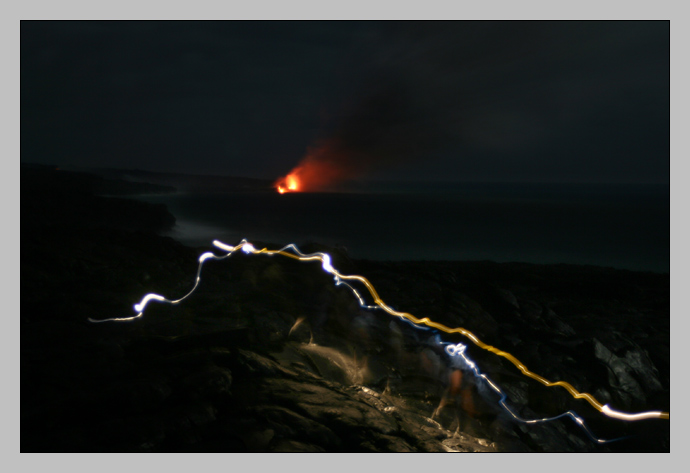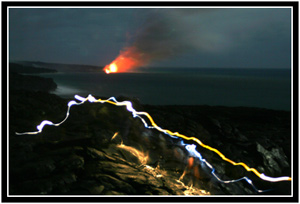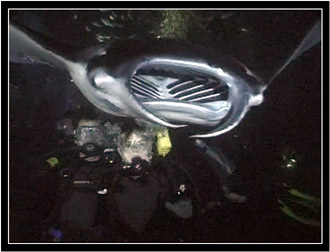HAVO Lights

The great tourist myth of Hawaii, perpetrated by all the television travel documentaries, is that you’ll see rivers of flowing lava. Indeed you will, if you go to any of the museums with video display terminals. Apparently, the really fantastic displays occur, oh, every ten or twenty years. And when they do, cars are piled up for miles and miles as even the locals cram closer for a look.
That’s not to say that you won’t get a chance to see some geothermal activity if you visit. A heli-tour over Kilauea might give you a peek down into its active crater. Sulfur steam vents abound in Hawaii’s Volcano National park. And if it’s the frozen black lava you’re after… Well! The Big Island’s got more of that than you can imagine.
One of my favorite nights on Kona was spent watching lava spill into the sea. The active craters of Kilauea are miles inland, but underground lava tubes transport a steady stream of molten rock to the sea. Where it meets the water, a huge cloud of steam billows upward. Due to a terrible parking space, we had to hurry to get out onto the lava field before dark.
Canon Digital Rebel XT
Date: 16 August 2005
Focal Length: 48mm
Shutter: 30 seconds
Aperture: F/4.5
Photoshop: Cropped, minor cloning away of lens artifacts,
somewhat extensive use of burn/dodge tools (never exceeding 30%)

 Despite going to bed relatively late after the night dive, our next day in Hawaii started very early. We didn’t realize it at the time, but it was to be the longest, most tiring day of our vacation.
Despite going to bed relatively late after the night dive, our next day in Hawaii started very early. We didn’t realize it at the time, but it was to be the longest, most tiring day of our vacation. When planning a vacation, I sometimes waffle between wanting to have a thorough, scheduled-to-the-day plan versus one built completely on freedom and spontaneity. I usually opt for the latter. For instance, when Oksana and I decided to spend a month in Costa Rica, the extent of our planning was to buy a guidebook and book round-trip tickets to San Jose. Everything, including the hotel we stayed in our first night, was found after we arrived.
When planning a vacation, I sometimes waffle between wanting to have a thorough, scheduled-to-the-day plan versus one built completely on freedom and spontaneity. I usually opt for the latter. For instance, when Oksana and I decided to spend a month in Costa Rica, the extent of our planning was to buy a guidebook and book round-trip tickets to San Jose. Everything, including the hotel we stayed in our first night, was found after we arrived.